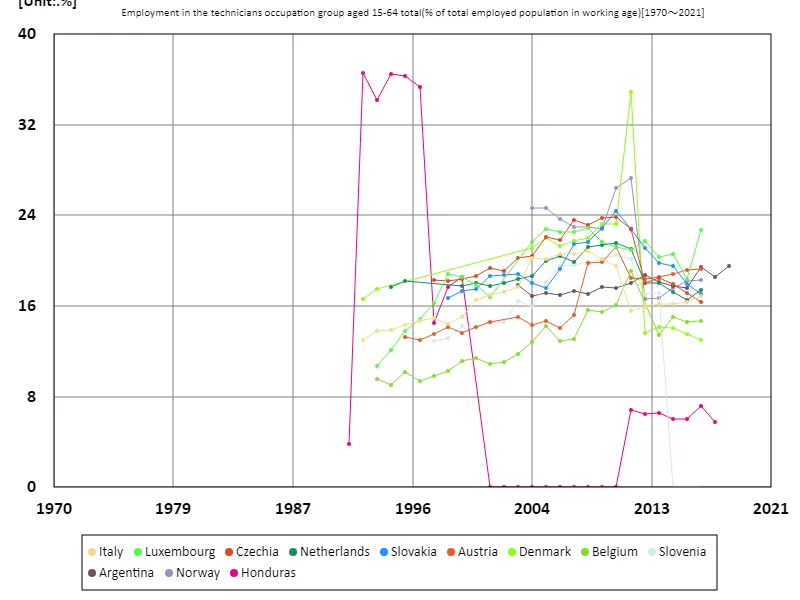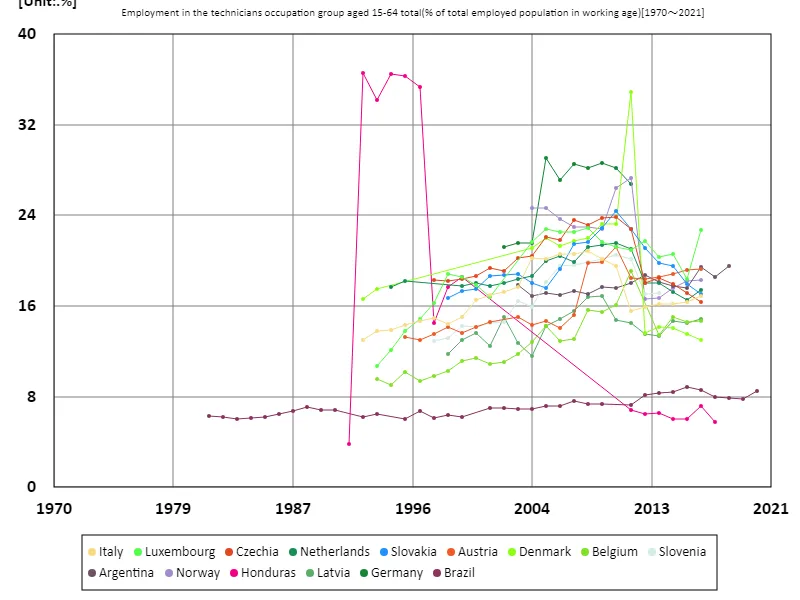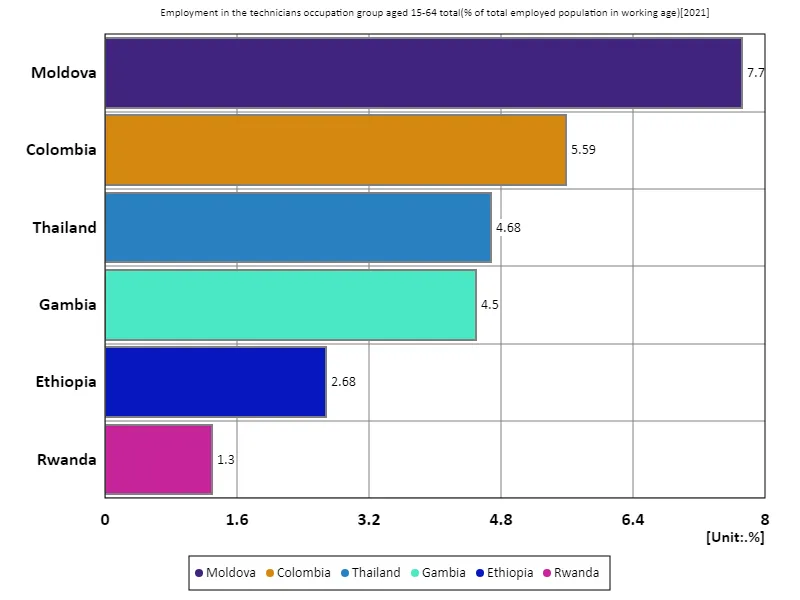- Abstract
- Employment rate for all 15-64 year olds, technical occupations (percentage of working-age population)
- Employment rate for all 15-64 year olds, skilled occupations (percentage of working age working population) (worldwide)
- Employment rate for all 15-64 year olds, skilled occupations (percentage of working age working population) (Worldwide, latest year)
- Reference
Abstract
Looking at the data on employment rates, it is noteworthy that Argentina has the highest employment rate in the technical sector, at 19.5%. This means that Argentina has a high demand for technical jobs and the labour market is eager to recruit people with technical skills. Meanwhile, employment rates in the technical sector vary widely across countries around the world. Influenced by factors such as the level of economic development, education system, and industrial structure, employment rates for technical occupations tend to be relatively low, especially in developing countries. While developed countries experience high employment rates, technological advances are often driving demand for technical jobs. Therefore, the employment rate in the skilled sector is an important indicator of a country’s economic maturity and technological strength.
Employment rate for all 15-64 year olds, technical occupations (percentage of working-age population)
Honduras’ skilled employment rate peaked at 36.6% in 1992, reflecting the economic growth and high demand for skilled jobs at the time. However, in 2018, this dropped to 15.8%, which is likely due to several factors. Economic changes, advances in technological innovation, or structural changes in the industry may have played a role. Fluctuations in employment rates for skilled occupations are closely linked to changes in a country’s industrial structure and education system. Overall, employment rates for skilled jobs tend to peak at higher levels in developing countries, while remaining stable or increasing in developed countries. In this age of technological innovation and digitalization, the importance of technical jobs is increasing, and many countries are seeing fluctuations in employment rates. The example of Honduras also shows a clear relationship between economic trends and demand for skilled jobs.


The maximum is 36.6%[1992] of Honduras, and the current value is about 15.8%
Employment rate for all 15-64 year olds, skilled occupations (percentage of working age working population) (worldwide)
Data from 1991 to 2018 show that Honduras’ skilled employment rate peaked at 36.6% in 1992, suggesting that the economic situation and industrial structure at the time may have been dependent on skilled jobs. However, the current low level of 15.8% reflects changes in the technology job market in Honduras. The significant decline in employment rates in technical occupations can be attributed to industrial transformation and economic challenges. In particular, advances in technological innovation may have changed the demand for technical jobs and reduced traditional occupations. The economic crisis and changes in the education system are also likely to have had an impact. On the other hand, employment rates in the skilled sector vary widely across countries, tending to remain stable or increase in developed countries. In contrast, in developing countries, economic fluctuations and changes in industrial structure often affect employment rates. The case of Honduras shows that skilled employment rates are closely linked to economic maturity and industry trends, reaffirming the importance of the role of skilled workers in international economic change.


The maximum is 36.6%[1992] of Honduras, and the current value is about 15.8%
Employment rate for all 15-64 year olds, skilled occupations (percentage of working age working population) (Worldwide, latest year)
According to 2021 data, Moldova recorded the highest employment rate in the skilled occupational sector among the working age group 15-64 years old at 7.72%, with an average of 4.41% and a total of 26.5% across the country. The data shows that employment in the technology sector varies widely across countries. Moldova’s high employment rate reflects the country’s recognition of the importance of technical jobs and its commitment to capitalizing on its skilled workforce. The employment rate in the technical occupational sector is influenced by a country’s economic structure, the level of industrial development, and the state of its education system. In developed countries, technological innovation and digitalization are driving increased demand for skilled jobs, leading to stable or rising employment rates. On the other hand, in developing countries, employment rates for skilled workers are often low, which is influenced by the structure of the economy and the level of education. The overall total of 26.5% shows that although the skilled sector plays an important role in the labour market in many countries, employment rates vary widely across countries. Fluctuations in employment rates for skilled occupations are directly linked to the stage of economic development and the progress of technological innovation, and are an important indicator for understanding changes in international labor markets.


The maximum is 7.72% of Moldova, the average is 4.41%, and the total is 26.5%



Comments